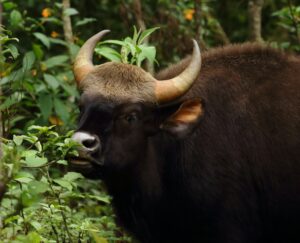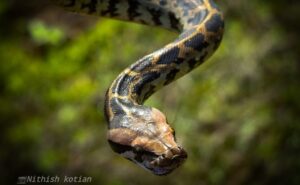

Vashishthi River is one of the largest rivers of the Konkan coast. The main part of Vashishthi basin falls in Ratnagiri district and covers an area of 2233 sq. kms, in the blocks of Guhagar, Dapoli, Khed and Chiplun. Vashishthi River flowing from Chiplun merges into the sea at Dabhol. There is a creek at a village Maldoli called as Maldoli creek.
What is in a name!
Maldoli is a quite village located 22 km away from Chiplun. Village got this peculiar name as in the past it was known for its baskets i.e. dolis for goods i.e. maal. Ships from the Arab countries used to come at Karambavane harbour with their goods. These goods then were transported to Chiplun market in small boats and carriages from a small village. As the goods were transported in Maldolis -Dolis to carry goods from this village, the village name became Maldol.
Crocodiles of Vasishthi
Maldoli creek is known for mugger crocodiles. It is one of three crocodilians species in India, other than saltwater crocodile (C. porosus) and gharial (Gavialis gangeticus).
According to IUCN 2009 red list mugger is Vulnerable species.
Once very common in rivers it has been exterminated from most of its range. Major threats to Mugger population are habitat destruction, fragmentation, and mortality due to increased fishing activities. Damming of rivers also alter their habitat drastically.
With habitat alterations and degradations there are fewer and fewer habitats for crocodiles. Vasishthi creek is one such non disturbed area which provides habitat to crocodiles.
Crocodiles Ecology
Crocodile is medium-sized, maximum length 4-5 m and has the broadest snout of any living member of the genus Crocodylus.
It is principally restricted to the Indian subcontinent where it may be found in several freshwater habitat types including rivers, lakes, marshes and in saltwater lagoons and estuaries.
Mugger is a hole-nesting species, with egg-laying taking place during the annual dry season. Mugger’s choice of habitat is also limited by its nesting need. Nests are in a wide variety of habitats like densely vegetated streams, tidal lagoons (Whitaker and Whitaker 1975).
Muggers are tolerant of conspecifics (members of same species ) but both sexes become territorial during breeding season.
Muggers feed on birds, monkeys, snakes, rodents, fishes etc. Hatchlings also feed on insects. Muggers have acute sense of sight, hearing and smell.
Their breeding season is from November to June in South and December to June in north.
Mugger was listed as Endangered species, in IUCN red data list before. With conservation efforts and protective status, the status is lowered to Vulnerable species.
Crocodile conservation started in 1975 in India. Sixteen crocodile rehabilitation centres and eleven crocodile sanctuaries were established for Crocodiles conservation in India.
Mugger is protected by law in all the countries where it is found.
Tourism Potential
River creek at Maldoli offers boat safari experience where crocodiles and water birds can be seen up close. Boat safari should be planned on a low tide day as water in the creek is stable and river banks are exposed. Crocodiles bask (exposing to sunlight for raising body temperature) on exposed banks and small river islands. Basking is an important activity for the crocodiles. If a boat comes near river bank, they can be seen belly running and jumping in water. Crocodiles are strong swimmers.
Water birds like Asian openbill, Grey Heron, Purple heron, Purple Moorhen, Common Sandpiper, Little Cormorant and many others can be observed on the river bank.
There is a need and scope for educating the tourists about crocodile ecology and importance of riverine habitats. This will broaden the base for public support for crocodile conservation.
Maldoli has untapped potential as conservation tourism. One of the not common species-Mugger can be observed here in its natural habitat. Maldoli also offers Kokani food and Konkani culture, at its best.

She conceptualized FORREST to conserve, to Inspire and to connect people back to nature. Her interest lies in Habitat ecology. A poet by nature with a touch of the wild.


We plan to restore a forest of 20000 trees in the monsoon of July 2021! And we need your help to do that! Contribute saplings in Vruksh Khosh or donate Rs. 50 per sapling.